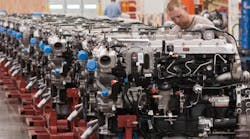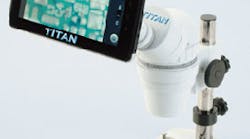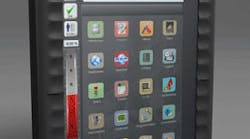Intermet Corp. reports its Columbus (GA) Foundry has adopted a laser scanning system that allows the ductile iron operation to produce “highly accurate” digital models of components, “improving everything from the speed of a production ramp-up to the efficiency of quality checks.”
The system involves a laser-based scanner mounted on an articulated, mechanical arm, and data-management software to track and record the dimensions of an object. The scanner covers the entire object, converting millions of measurements into a computer-rendered "point cloud" that recreates the casting in a digital presentation.
Laser scanning is being used to aid rapid prototyping, as well as 3-D modeling, and Intemet says this approach improves on coordinated measurement machines (CMMs), which are slower, require more programming, and measure just one area of an object at a time.
Intermet adds that customers are benefiting from its improved ability to troubleshoot design problems, and to create precise, digital records of prototypes and final parts. It says laser scanning supports two of its corporate goals: providing “industry leading” customer service and ensuring dimensional accuracy for every casting produced.
"From the customer's standpoint, this reduces the lead time to provide them with a casting," stated Coumbus Foundry technical director Art Clark. "It's also an invaluable tool improving our ability to monitor production and provide fast, accurate data to our customers.”
Typically, the parts can be scanned in 30-40 minutes, which reduces the time needed to complete dimensional studies from weeks to days. Intermet says it can overlay a production part onto a reference part, with each one rendered in different colors to identify discrepancies. Similarly, the "point cloud" can be compared to CAD designs to check production accuracy.
And, according to Intermet, when planning production of a new part, a model’s dimensions can be scanned in just a few hours and delivered back to the customer. All this reduces overall cost and training time, too.
"Customers want us to make sure their part is dimensionally sound," Clark continued. "The old method was to take the part and then spend a lot of time programming the coordinate measuring machine. And you were only as good as your program. It would only measure where you told it to measure."
The laser scanner, on the other hand, covers the whole object, makes millions of measurements and reproduces a "point cloud" on a computer screen. "Not only do you get more points, but you acquire them much more quickly," Clark said.
"This investment in technology has provided us with everything we hoped for and more," according to Clark. "It has dramatically upgraded the service we provide while cutting our response time to our customers."
Latest from Uncategorized
Latest from Uncategorized
Uncategorized
Newsletter Confirmation Page
May 27, 2013
Uncategorized
Vented Safety Helmet
July 21, 2012
Melt/Pour
A Plan Comes Together
July 5, 2012
Uncategorized
Convert Microscope to Videoscope
July 2, 2012
Uncategorized
Robot Programming with Tablet-PC
July 2, 2012



